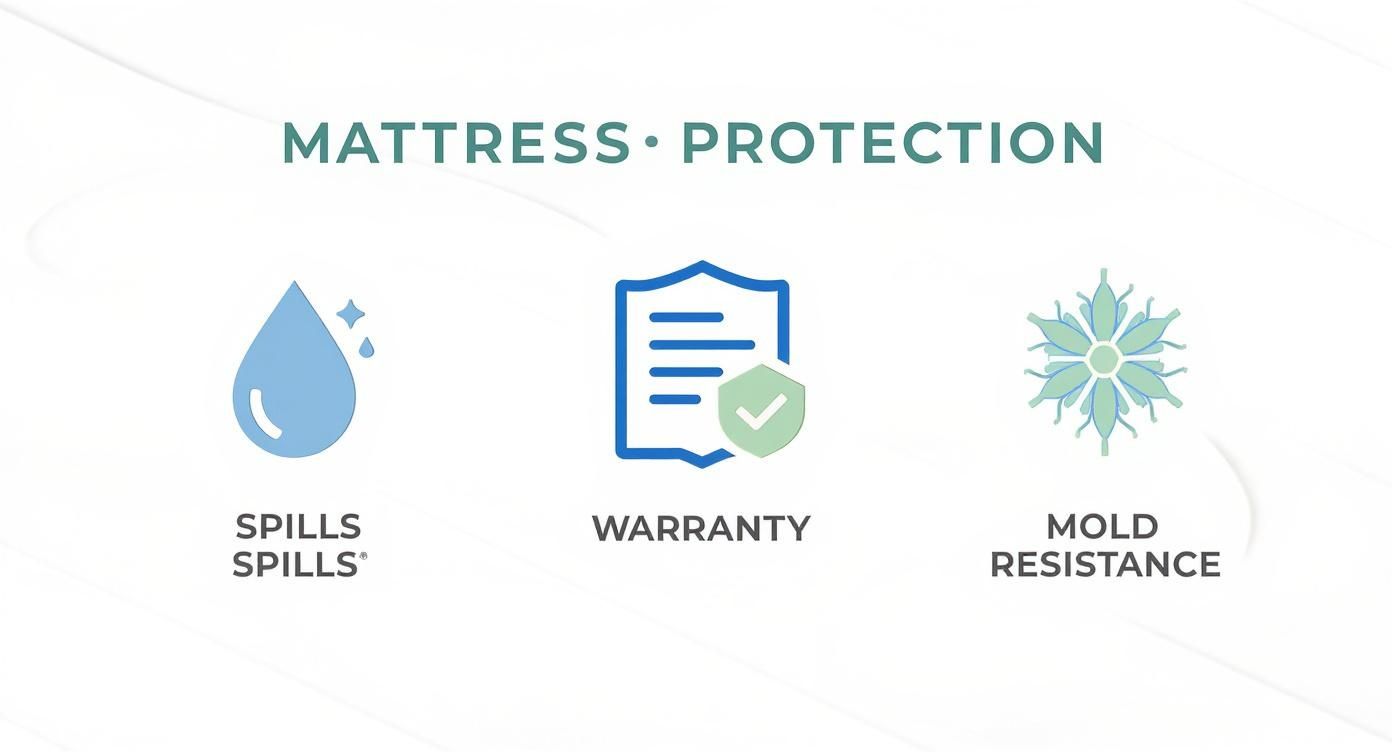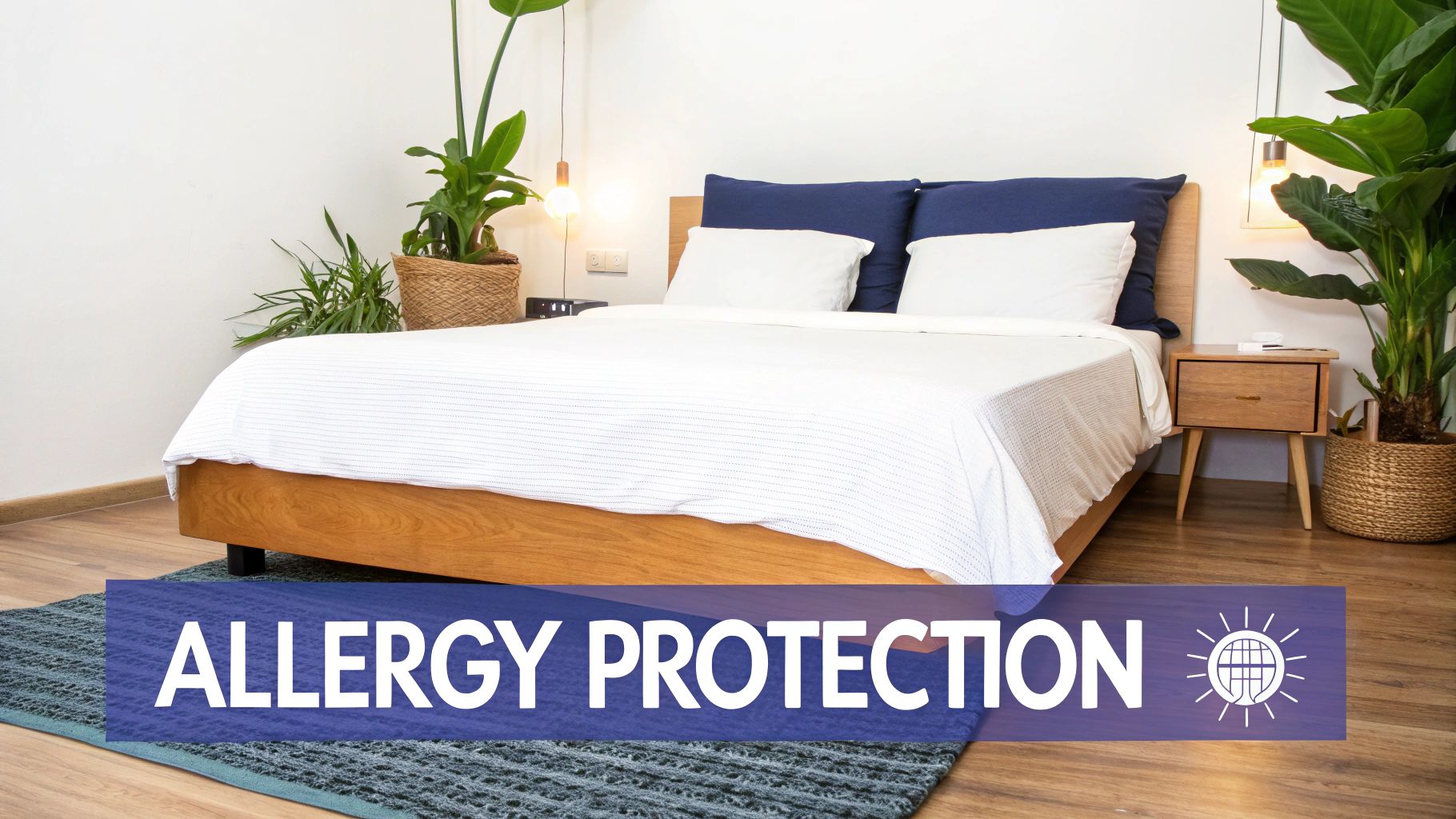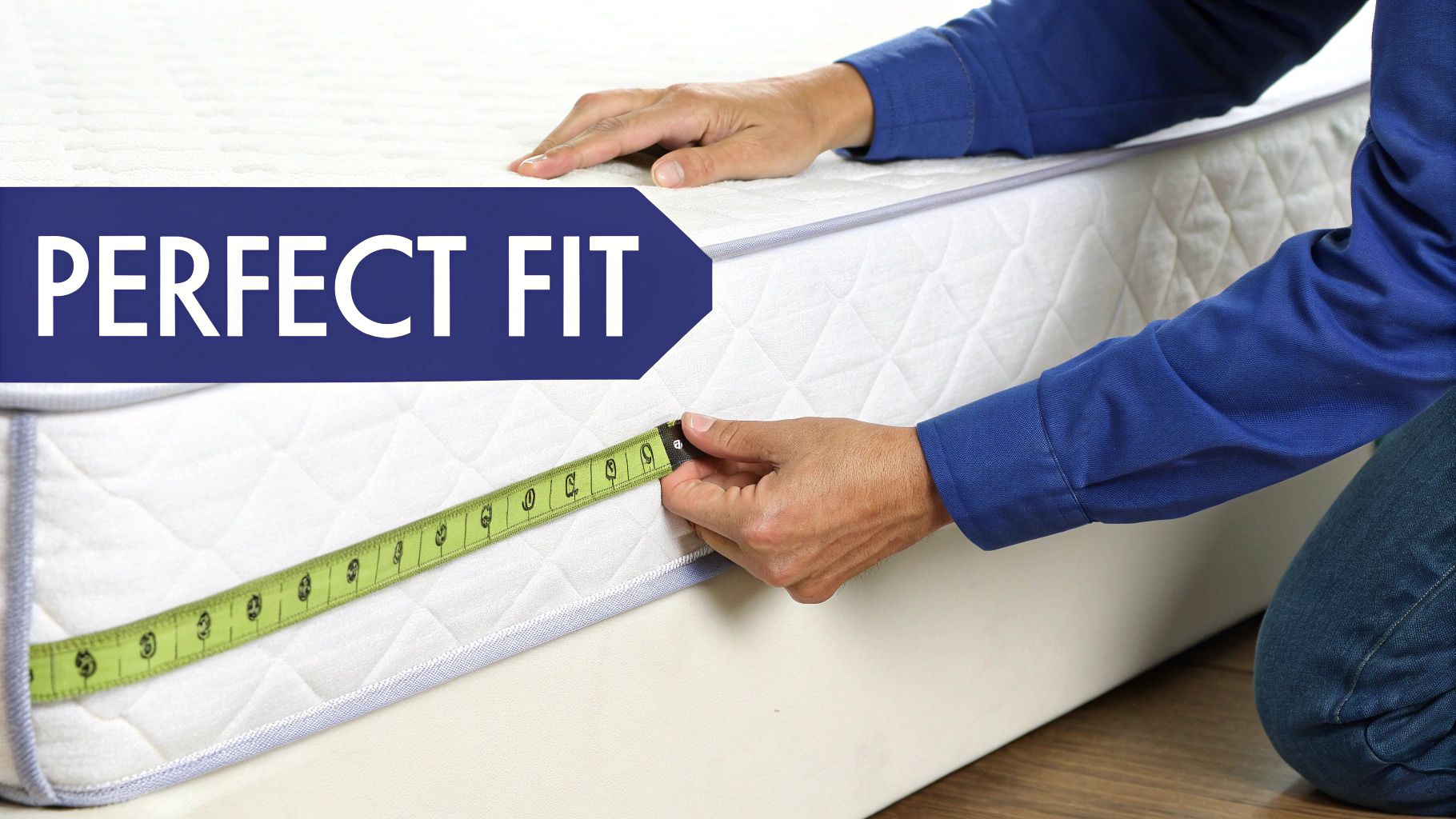Let's be honest. When you invest in a quality mattress, you're not just buying a place to sleep—you're investing in your health and wellbeing. So, why would you leave it unprotected? A mattress protector waterproof NZ families can count on is the single best insurance policy for your bed, shielding it from the spills, sweat, and accidents that can ruin it for good and even void your warranty.
Why Your Mattress Desperately Needs a Waterproof Protector
Think of your mattress as a long-term investment. You wouldn't carry a brand-new smartphone without a case, right? Leaving your mattress unprotected is taking the same kind of gamble.
Life is messy. Whether it's a spilt cup of coffee during a lazy Sunday morning or a child's nighttime accident, moisture is the ultimate enemy of your mattress. Once liquid seeps into those deep layers of foam and fabric, it’s practically impossible to get it all out. This creates a damp, hidden environment perfect for mould, mildew, and bacteria to thrive—a real concern in New Zealand's often-humid climate.
Keep Your Warranty and Resale Value Intact
Here’s a sneaky detail many people miss: most mattress warranties have a clause that says a single stain can make it completely void. That's right. If a genuine manufacturing fault appears down the line, the company can refuse to honour the warranty just because of a small, unrelated mark. A waterproof protector keeps your mattress looking brand new, protecting its condition and your consumer rights.
A waterproof protector isn't just an accessory; it's a non-negotiable part of your bedding. It works silently every night to keep your mattress hygienic, extend its life, and give you total peace of mind.
A Shield Against Life's Little Disasters
Accidents happen. It's just a part of life, whether you have pets, kids, or are just a bit clumsy sometimes. A waterproof protector is your best defence against spills, but if you're dealing with a particularly stubborn accident, check out a detailed guide on tackling urine stains.
This simple layer offers so much more than just spill protection:
- Creates a Healthier Sleep Space: It forms a barrier that stops sweat, body oils, and dead skin cells from seeping into your mattress, which helps prevent the build-up of allergens like dust mites.
- Boosts Durability: By keeping the inside of your mattress dry, a protector stops the foams and fibres from breaking down prematurely. This helps your mattress stay supportive for years longer.
- Makes Cleaning a Breeze: Forget trying to deep-clean a huge, heavy mattress. You can just whip off the protector and toss it straight into the washing machine.
At the end of the day, spending a little on a quality mattress protector waterproof NZ families trust is a smart move that pays off big time. It keeps your bed cleaner, makes your mattress last longer, and ensures you get every dollar's worth out of your investment.
Choosing the Best Protector Materials
When you're on the hunt for the perfect mattress protector waterproof NZ retailers offer, the material is the most critical factor. It's the difference between a comfortable, quiet night's sleep and a sweaty, crinkly one.
Remember, this layer sits right under your fitted sheet, so it has a massive impact on how your bed feels. Let's break down the common materials so you can find the one that’s right for you.
Natural Fibres For Breathable Comfort
For a lot of Kiwis, nothing beats the feel of natural fibres. They’re known for being soft, breathable, and great at managing moisture—all the ingredients for a fantastic night's sleep.
- Cotton: It’s the undisputed champion of bedding for a reason. Cotton is soft, durable, and brilliant at absorbing moisture, which helps keep you feeling cool and dry. A fan favourite is terry cotton, with its familiar, soft towel-like texture. It's super absorbent yet comfortable. Our terry cotton mattress protector is a perfect example of this reliable choice.
- Bamboo: If you love a silky-smooth feel, you'll love bamboo. It's incredibly soft, naturally hypoallergenic, and a champion at regulating temperature. It actively wicks moisture away from your skin, making it a brilliant pick for anyone who sleeps hot.
It's no surprise that cotton dominates the bedding protector market. It holds the largest global market share and heavily influences what New Zealanders choose for their beds. The simple demand for breathable, natural fabrics has cemented cotton as the go-to for its unbeatable comfort and moisture-wicking power.
The infographic below really drives home why protecting your mattress is so important, from shielding it against spills to keeping mould at bay.

As you can see, a good protector is your mattress's best friend, defending it from spills, keeping the warranty intact, and stopping nasty mould growth before it starts.
Advanced and Synthetic Options
While natural fibres are fantastic, don't overlook modern synthetics. They bring some impressive performance benefits, especially when it comes to durability and advanced moisture control.
- Polyester: Think of polyester as the workhorse of fabrics. It’s incredibly durable, resists stretching and shrinking, and is a breeze to look after. You'll often find it blended with cotton to give you the best of both worlds: the softness of a natural fibre and the strength of a synthetic.
- Tencel™: This is a branded lyocell fabric made from eucalyptus wood pulp, and it feels unbelievably smooth and silky. Tencel™ is famous for its moisture-wicking ability, pulling sweat away from the skin even more effectively than cotton. It’s a game-changer for anyone who tends to overheat at night.
Comparing Common Mattress Protector Materials
To make things easier, here's a quick comparison to help you pinpoint the best option for your sleep style and needs.
| Material | Key Benefit | Best For | Breathability |
|---|---|---|---|
| Cotton | Soft, absorbent, and durable | Everyday use and all-around comfort | High |
| Bamboo | Silky-soft and temperature-regulating | Hot sleepers and sensitive skin | Very High |
| Polyester | Extremely durable and easy care | Budget-conscious buyers and longevity | Moderate |
| Tencel™ | Ultra-smooth and superior moisture-wicking | Those who overheat or want a luxury feel | Excellent |
Each material offers a distinct feel and set of benefits. Your choice really comes down to what you value most—whether it's the classic comfort of cotton, the silky touch of bamboo, or the high-tech performance of Tencel™.
The Secret Behind the Waterproofing
So, what’s the magic that makes these protectors waterproof? It all comes down to a hidden barrier. In the old days, this layer was often made of vinyl (PVC), which was noisy, stuffy, and felt like sleeping on a plastic bag. Not exactly a recipe for sweet dreams.
Thankfully, technology has come a long way. The industry standard today is TPU (Thermoplastic Polyurethane), a whisper-quiet, flexible, and breathable membrane bonded to the underside of the fabric.
TPU is microporous. What does that mean? Its tiny pores are big enough to let air and water vapour (your body heat) escape, but far too small for liquid molecules to get through. This clever tech keeps your mattress 100% safe from spills and accidents without trapping heat or making those annoying crinkly sounds every time you move. It’s the silent hero doing all the hard work, so you don't even know it’s there.
The Hidden Health and Hygiene Benefits

While stopping a spilled cup of coffee from ruining your mattress is a big win, the most important work a waterproof protector does is often invisible. It’s not just about guarding against obvious stains; it’s about creating a genuinely healthier, more hygienic place to rest your head each night.
Think of your unprotected mattress as a giant sponge. Night after night, it soaks up sweat, body oils, and millions of dead skin cells. This creates the perfect, cosy home for things you'd really rather not share your bed with.
Creating a Barrier Against Allergens
For many Kiwis, an unprotected mattress is a playground for dust mites—a major trigger for allergies and asthma. These tiny creatures love to feast on the skin cells we naturally shed, thriving deep inside the warm, humid fibres of a mattress.
A waterproof mattress protector puts a stop to all that. By forming an impenetrable barrier, it prevents skin cells and moisture from ever reaching the mattress. You're essentially cutting off the dust mites' food and water supply.
This simple shield makes a world of difference:
- Reduces Dust Mite Populations: By taking away their food source, you stop them from multiplying and turning your bed into a thriving colony.
- Blocks Pet Dander and Pollen: If you have pets or suffer from hay fever, the protector stops dander and pollen from getting trapped deep in your mattress.
- Creates an Allergy-Friendly Bed: This makes it an essential piece of kit for anyone with respiratory issues, helping to ease nighttime sneezing, stuffiness, and itchy eyes.
By creating this effective shield, a protector transforms your bed from an allergen hotspot into a clean sanctuary. It's a proactive step that can genuinely improve your breathing and the quality of your sleep.
Preventing Mould and Mildew Growth
Let's face it, New Zealand's climate can be damp, and that moisture loves to find its way into our homes. Your mattress is a prime target, as body heat and humidity can get trapped inside, creating the perfect breeding ground for mould and mildew.
A mattress protector waterproof NZ families rely on stops this moisture in its tracks. It ensures not a single drop gets through, keeping the core of your mattress completely dry. Given the hidden dangers of mould, keeping it out of your bed is non-negotiable for your health.
A dry mattress is a healthy mattress—free from musty smells and nasty spores. This makes a protector one of the best tools for maintaining good air quality in your bedroom.
And it's not just your mattress that needs protecting. The same logic applies to your pillows, which is why we always recommend looking into pillow protectors in NZ to keep your whole sleep setup fresh and hygienic.
Finding the Perfect Style and Fit for Your Bed

Even the best mattress protector waterproof NZ homes can have will let you down if it doesn't fit properly. Too loose, and it will bunch up annoyingly under your sheets. Too tight, and it’s a mission to get on and off, which can damage both the protector and your mattress.
You want a fit that’s so snug you forget it’s even there—that’s the secret to silent, invisible protection. Let’s look at the two main styles and how to measure up for that perfect fit.
Fitted Sheet vs Full Encasement Protectors
In New Zealand, mattress protectors generally come in two main styles, each offering a different level of protection and convenience.
-
Fitted Sheet Style: This is by far the most popular type, and for good reason. It goes on just like a fitted sheet, with an elasticated skirt that tucks neatly under the mattress. It’s a breeze to put on and, more importantly, just as easy to whip off for washing. This style does an excellent job of protecting the top and sides of your mattress from everyday spills and allergens.
-
Full Encasement Style: Think of this as the Fort Knox of mattress protection. It provides complete 360-degree protection by sealing the entire mattress inside a zippered cover. If you’re serious about defending against bed bugs, dust mites, and major allergens, this is the ultimate choice—there's simply nowhere for them to get in. The trade-off is that it’s a bit more work to take off for cleaning.
For most of us, the fitted sheet style hits the sweet spot. It gives you all the protection you need for everyday life while being incredibly practical and easy to look after.
How to Measure Your Mattress for a Snug Fit
Getting the right size isn't just about knowing you have a Queen or a Super King. The most important number you need is the mattress depth. This single measurement will determine whether the protector’s skirt grips your mattress securely or keeps annoyingly popping off the corners.
Here’s how to do it in one minute:
- Strip the Bed: Take everything off, including sheets and any mattress toppers. You need to measure the mattress itself.
- Measure the Depth: Using a tape measure, measure from the bottom edge of the mattress straight up to its highest point. If you have a plush pillow-top, make sure you measure right to the very peak of that cushioning.
- Check the Product Details: When you’re shopping, look for the "skirt depth" or "fits mattresses up to X cm" in the product specs. You should always pick a protector with a skirt that’s at least as deep as your mattress, if not a couple of centimetres deeper. This gives it enough fabric to tuck firmly underneath.
Knowing your bed's exact dimensions is key. If you're not sure about standard Kiwi bed sizes, our guide on what size a queen mattress is is a great place to start. A few moments spent measuring now will save you a lot of hassle later.
How to Care for Your Waterproof Mattress Protector
Getting the most out of your waterproof mattress protector comes down to proper care. Think of it like a high-performance raincoat – you wouldn't toss it in a boiling wash and expect it to keep you dry. The delicate waterproof membrane in your protector needs a little TLC to keep doing its job year after year.
A few simple habits are all it takes to extend its life, ensuring it keeps guarding your mattress silently and effectively.
Washing and Drying Best Practices
First rule: always check the care label on your protector. That said, most modern protectors share some common guidelines. When it's wash day, use a cool or warm gentle machine cycle. A good rule of thumb is to keep the temperature at 40°C or below. Anything hotter risks damaging the thin waterproof backing, causing it to peel or lose its waterproof qualities.
Be sure to use a mild, gentle detergent. Harsh chemicals are your protector's worst enemy.
A critical tip: steer clear of chlorine bleach and fabric softeners. Bleach is far too aggressive and can eat away at the waterproof membrane. Fabric softeners coat the fabric with a residue that clogs its pores, which ruins its breathability and can damage the waterproof layer over time.
When it's time to dry, think low and slow. A tumble dry on a low heat setting is usually fine, but line drying in the shade is even better. Avoid harsh, direct sunlight, as the intense UV can make the waterproof layer brittle over time. High heat and ironing are absolute no-gos – they can melt the protective film and cause permanent damage.
Following these simple steps will protect your investment and keep your protector working perfectly. Proper care is also a big part of keeping your sleep environment hygienic. For more tips on keeping your whole bed fresh, have a look at our guide on cleaning a mattress.
Your Top Mattress Protector Questions Answered
Even after getting all the details, you might still have a few questions. That's completely normal when you're choosing the best mattress protector waterproof NZ families rely on. Let's tackle the most common queries so you can feel totally confident in your choice.
Will It Make Me Sleep Hot?
This is probably the number one concern we hear. The short answer? Not if you get the right one. Gone are the days of crinkly, sweaty plastic sheets. Modern protectors use a clever, breathable TPU membrane that allows air to flow freely, stopping heat from getting trapped.
Materials like bamboo and Tencel™ are also brilliant at wicking away moisture and keeping your temperature just right. You get all the protection without that stuffy, overheating feeling.
Can I Still Use My Electric Blanket?
Absolutely. You can safely use an electric blanket with most high-quality waterproof protectors. The key is to ensure the protector fits your mattress snugly, with no loose fabric that could bunch up and create a potential hot spot.
It's always a good idea to double-check the manufacturer's guidelines for both your electric blanket and the protector, just to be safe.
How Often Should I Wash My Protector?
For a fresh and hygienic bed, popping your protector in the wash every one to two months is a great rule of thumb.
However, if you're dealing with allergies, have pets who love to snooze on the bed, or if there's been a spill, you’ll want to wash it more often. In those cases, washing it every few weeks is a better bet.
Regular washing does more than just keep things fresh. It gets rid of allergens like dust mites and pet dander, making sure your protector is always working to create a healthy sleep space.
This simple bit of upkeep stops bacteria from building up and keeps your protector doing its job properly. If you have more questions about caring for your bedding, our team has put together a handy list of answers. You can explore our frequently asked questions for more insights.
A little bit of consistent care goes a long way, ensuring your protector provides a reliable, invisible defence for your mattress for years to come.
Ready to give your mattress the ultimate protection it deserves? At New Zealand Bed Company, we offer a range of high-quality, breathable, and quiet waterproof mattress protectors designed for Kiwi homes. Find the perfect mattress protector for your bed today!

